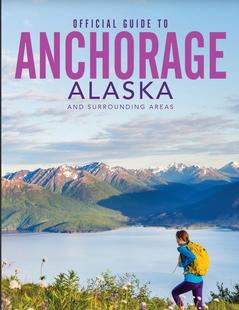Basics
- Length:
- 3500 miles (5632 km)
- Time:
- One-day excursions, two to five day itineraries, or see the entire Byway over the course of several weeks.
- Fees:
- Check with the Alaska Marine Ferry for up-to-date prices.
Description
If you want to see Alaska, take the ferry! The only Byway of its kind, Alaska's Marine Highway lets you leave the driving to someone else as you travel along scenic coastal routes totaling over 8,000 miles. See whales, active volcanoes, glaciers, fjords, and sea lions from the deck! And the adventure doesn't end when the sun goes down. Just book your own cabin on the ferry, pitch a tent, or roll out a sleeping bag on the upper decks, lay back, and watch the dancing northern lights.
Enjoy a wide variety of wildlife, and awe-inspiring natural beauty as you travel Alaska's Inside Passage. From the southern terminus in Bellingham::: WA, the ferries ply waters lined with the lush, green rainforests of British Columbia and Alaska as they weave among more than 1,500 islands. Along with gorgeous scenery this area is steeped in Native, Early Russian, and Gold Rush history. If you're heading north you can end your sail in Haines or Skagway to connect to the Yukon or other Alaska scenic highways, such as the Haines Highway and the Taylor/Top of the World Highway.
The coastal communities of Southcentral Alaska are the outdoor playgrounds for more than half of the state's population. Take the ferry through beautiful Prince William Sound and into the Gulf of Alaska and Lower Cook Inlet. Thrill to spectacular views of ice-blue glaciers, tranquil fjords, lush forests, and unbelievable concentrations of seabirds and marine wildlife. This section of the Highway also provides easy access to several other Alaska State Scenic Byways such as the Seward Highway All-American Road, the Alaska Railroad, and the Richardson Highway State Scenic Byway.
Remote, beautiful, and mysterious best describes Alaska's Southwest. From gentle coastal grasslands to rumbling, snow-capped volcanoes, Southwest Alaska has a character and charm all its own. This land of mystery is home to numerous national wildlife refuges, hundreds of species of sea birds, fur seal colonies, walrus and other wildlife.
Helpful Links
Points of Interest
Points of Interest Along The Way
Alaska Maritime National Wildlife Refuge (AK)
The refuge is headquartered in the Alaska Islands and Ocean Visitor Center located in Homer, which is at the end of the Sterling Highway, approximately 225 miles south of Anchorage.
One of the most interesting ways to experience the refuge, if you have the time, is by traveling on the Alaska ferries from Homer to Kodiak or Unalaska during the summer. Refuge naturalists accompany the boats, presenting wildlife programs and helping passengers identify the birds and mammals seen along the way.
Directions
Take a tour boat from Homer, Seward, or Sitka. Or charter a boat from Unalaska.
Alaska Peninsula (AK)
The Alaska Peninsula is a geological active landform noted forits glaciers, volcanoes and outstanding scenic landscapes.
Directions
Southwest Alaska and the Aleutian Islands
Alaska Peninsula National Wildlife Refuge (AK)
Alaska Peninsula National Wildlife Refuge presents a breathtakingly dramatic landscape made up of active volcanoes, towering mountain peaks, rolling tundra and rugged, wave-battered coastlines.
Anchorage (AK)
The city of Anchorage began as a ramshackle community of railline workers living in tents. The community, settled in 1915, hasgrown and evolved into the largest city in Alaska with 260,000people.
For a look at Alaska culture, Anchorage is the place to be.Explore the Anchorage Museum of History and Art or the AlaskaNative Heritage Center for a taste of what Alaska has to offer.
Directions
From Whittier head north on A1 and follow signs to Anchorage. Trip takes about 70 minutes.
Aniackchak National Monument (AK)
One of the finest examples of dry caldera in the world, the Aniakchak Caldera is the result of a series of eruptions as recent as 1931.
Directions
On the western arm of Alaska, near Chignik.
Becharof National Wildlife Refuge (AK)
The Refuge's approximately 1,157,000 acres of land include rolling tundra, towering mountain peaks, and wave-battered coastline.
Chugach National Forest (AK)
The Chugach National Forest is the second largest forest in the National Forest System. Roughly the same size as the states of Massachusetts and Rhode Island combined, the Chugach (pronounced Chew'gatch) is the most northern of National Forests, only 500 miles south of the Arctic Circle. One third of the Chugach is composed of rocks and moving ice. The remainder is a diverse and majestic tapestry of land, water, plants and animals. The mountains, lakes, and rivers of the Kenai Peninsula, the islands and glaciers of Prince William Sound, and the copious wetlands and birds of the Copper River Delta make this National Forest a mecca for adventurers.
Glacier Bay National Park (AK)
A living laboratory, the marine wilderness of Glacier Bay allows visitors opportunities for adventures in observation.
Directions
In the eastern section of the Byway, between Skagway and Yakutat.
Haines (AK)
Located at the northern extent of the Inside Passage route, thiscommunity is situated along the Chilkat River. This is a popularport community linked to the traditional highway system thatconnects to the Alaska Highway via the Haines state scenicbyway.
The community is also popular for its bald eagle population inthe autumn. In October, the world's largest number of bald eaglesgather in Haines to take advantage of the late salmon run. Thisamazing gathering of eagles is the basis of the Bald Eagle Preserveand Annual Festival held in their honor.
Directions
Inside Passage
Homer (AK)
Located on the Kenai Peninsula, Homer is the home port for alarge fleet of halibut charter operators fishing the rich andscenic waters of Kachemak Bay.
"The Spit" is where all the action in Homer takes place. Bothcommercial fishing boats and leisure fishermen gather at The Spitfor boating and fishing. Also located in Homer is the AlaskaMaritime National Wildlife Refuge. The refuge is home to seabirdswho find a habitat in the rocks and reefs of Alaskan islands.
The new Alaska Islands and Ocean Visitors Center in Homer is a world-class interpretive facility that covers the marine habitats of the Alaska National Marine Refuge. In this respect, it is the gateway to the Aleutian Island chain.
Directions
Downtown Homer is 3 miles from the terminal and the Visitor Center is 5 miles. Regular, shuttle and taxi service is available from the terminal. Visitor services are less than 1/2 mile, from the terminal.














